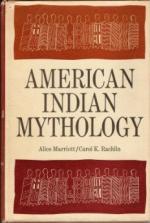|
This section contains 796 words (approx. 2 pages at 400 words per page) |

|
American Indian Mythology Summary & Study Guide Description
American Indian Mythology Summary & Study Guide includes comprehensive information and analysis to help you understand the book. This study guide contains the following sections:
This detailed literature summary also contains Topics for Discussion on American Indian Mythology by Alice Marriott and Carol K. Rachlin.
This book is a compilation of several short retellings of North American Indian myths and legends. Stories of how the world came to be the way it is, how people came to be the way they are, and cautionary tales about the way people are meant to behave are juxtaposed with sometimes metaphoric, sometimes graphically realistic tales recounting the ways in which white men came to dominate the Indians. Each story, according to notes provided by the editors, is a transcription of a narrative told them by an Indian elder or storyteller. In many cases, there is the sense throughout the book of a direct line of com-munication between those who originally lived the stories, and those who have lived to tell them.
The book begins with an extensive introduction describing the anthropological origins of the North American Indian people, and the development of their myths and legends. The Introduction also examines the altering and frequent elimination of Indian culture by the aggressive forays of white culture, influence, and military strength into Indian territory, both geographical and spiritual.
The stories themselves are divided into four main categories. The first is entitled "The World Beyond Ours", and contains what could broadly be described as stories of origin. These include tales of how the world came to be, how the light of the sun was brought into the world, how the constellations were formed, and how specific geological and/or natural phenomena came into being. The second category of story is entitled "The World Around Us", and contains stories that describe specific circumstances within the history of the Indian people. These include narratives of how Indian people came into the world, how corn and buffalo became their main sources of food, and how certain animals (such as the turtle and the bear) came to be the way they are.
The third category of story is entitled "The World We Live In Now", and contains two different types of stories. The first has to do with relationships between Indians and White Men, and in particular the way Indians were at times victimized by white diseases as well as by white military and economic conquest. The second type of story portrays the way Indian spirituality adapts and persists in contemporary, white-dominated society and culture. The fourth category of story in this book is the briefest, and contains stories relating to the Indian experience of life after death.
An interesting aspect to this collection of myths, legends, and fact-based narratives is that in its structure can be found an almost novelistic sense of through-line. The first story is one of how the world came into being, while the last is one of how individuals living in that world come to the end of their existence, the thematic point of that story being that life is a cycle-what is at the beginning is at the end, which is itself a beginning. The stories between these two points paint a picture of a culture going through extensive transformations, internal ones triggered by the Indians' own quest for wisdom and knowledge as well as external transformations triggered, and sometimes forced, by the ever-increasing influence of the White Man. As the Indians struggle, are sometimes defeated, and sometimes triumph, their spiritual beliefs evolve but essentially remain intact. In other words, the stories of this book chronicle the spiritual journey not of an individual, as a novel might do, but of an entire people.
This journey plays out on what might be described as a traditionally epic scope. The Creator plays a direct role in many stories in the same way as, for example, the Greek gods became involved in the lives of those who worshipped them. Humans are taught lessons by their encounters with mystical, spiritual beings-as they are in mythologies throughout the world. Finally, stories play out on a large physical canvas. Great plains, mighty rivers, baked deserts and towering mountains are all central in these myths in the same way that the Nile is central to Egyptian mythology and the climate is central to the myths of Scandinavia. In fact, careful reading and interpretation of the stories in this book will reveal similarities between several of its key spiritual components and those of other belief systems; not only ancient mythologies like the Greek and/or Egyptian, but also of contemporary religions, such as Christianity and Buddhism, in particular. Here, perhaps, is the book's greatest value. In spite of the fact that many of its stories are defined by the differences between white and Indian culture, there is nevertheless the suggestion that these two cultures, and perhaps even any society that has a spiritual belief system integrated with its culture, are more similar than they might first appear to be.
Read more from the Study Guide
|
This section contains 796 words (approx. 2 pages at 400 words per page) |

|



